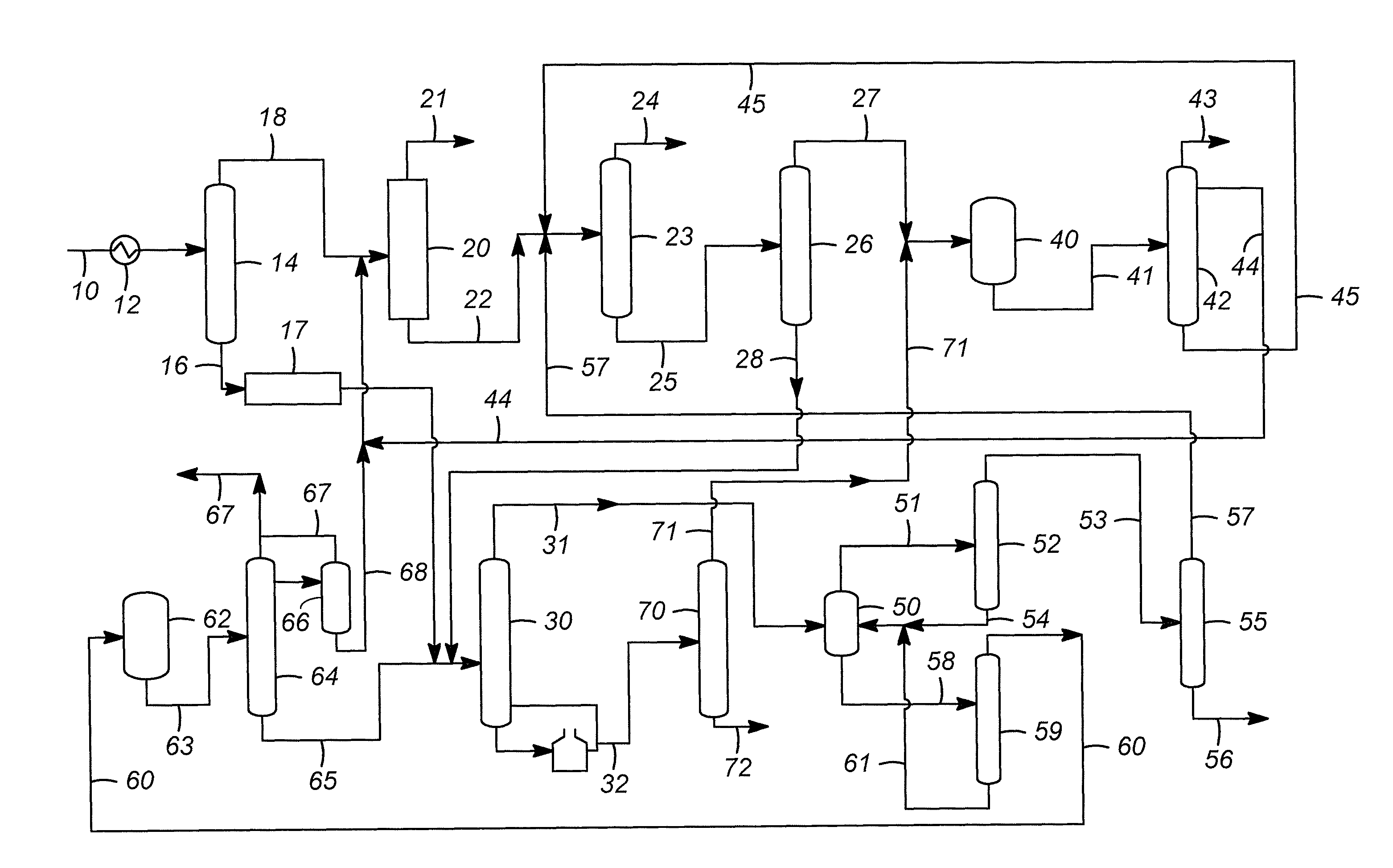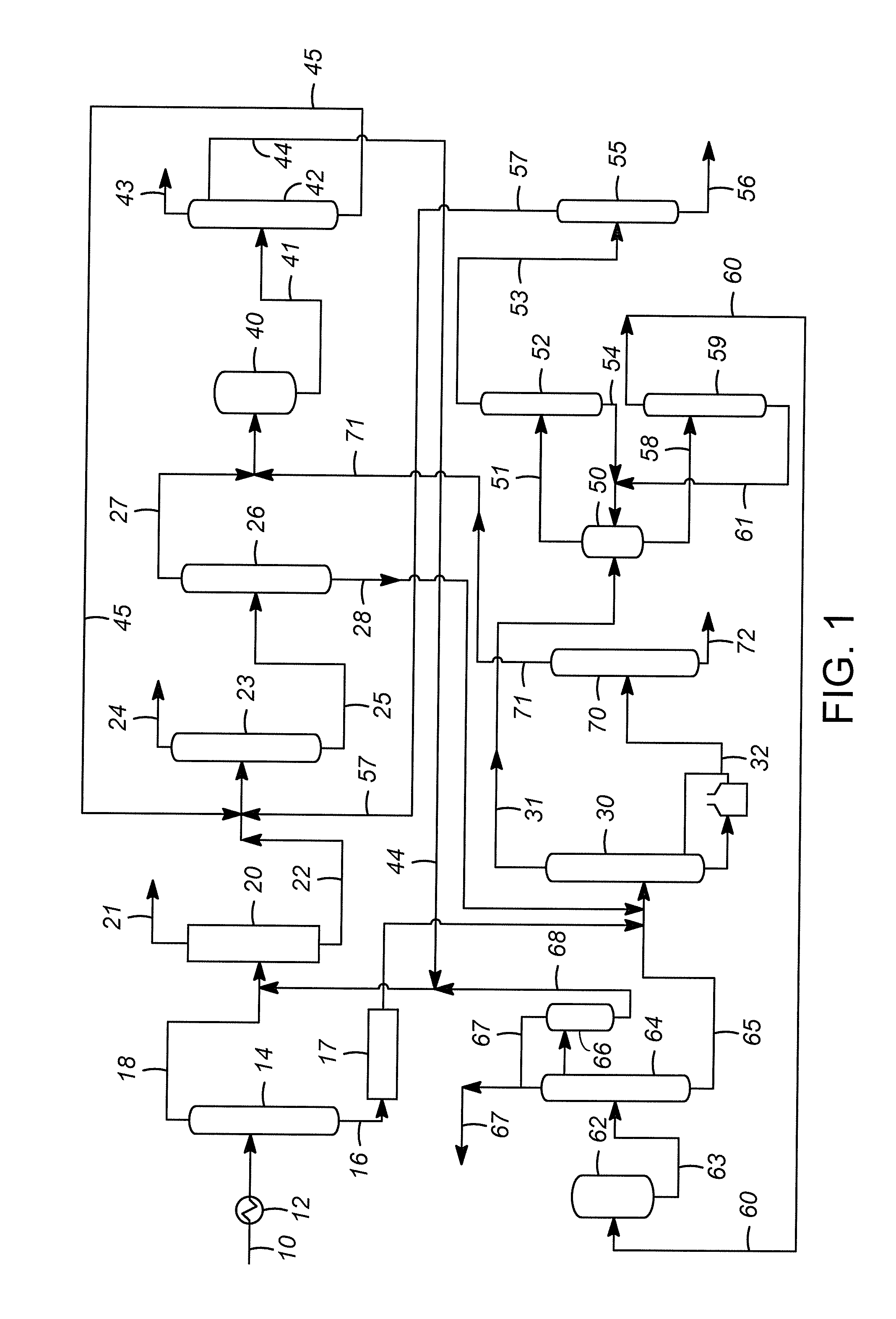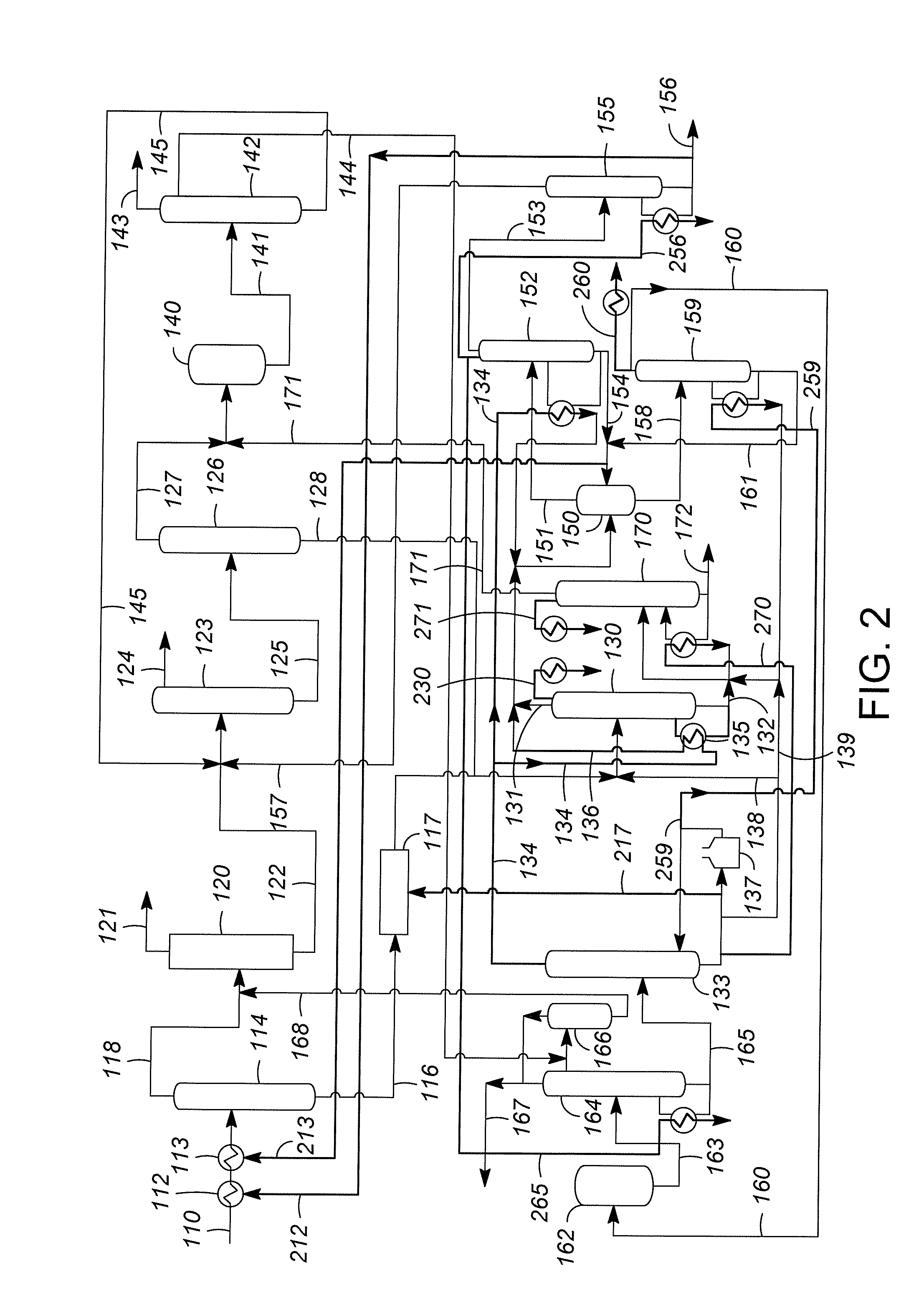Energy Conservation in Heavy-Hydrocarbon Distillation
Active Publication Date: 2012-03-01
UOP LLC
View PDF9 Cites 33 Cited by
- Summary
- Abstract
- Description
- Claims
- Application Information
AI Technical Summary
Benefits of technology
[0006]A broad embodiment of the present invention comprises a distillation process comprising two or more xylene columns separating C8-aromatics streams from a C9-and-heavier aromatics streams contained in at least one higher-boiling and at least one lower-boiling feed stream, wherein the at least one higher-boiling feed stream has a higher content of C9-and-heavier aromatics than the at least one lower-boiling feed stream, comprising distilling the at least one higher-boiling feed stream in at least one first low-pressure xylene column to separate a first C8-aromatics stream from a first C9-and-heavier aromatics stream; distilling the at least one lower-boiling feed stream in at least one second xylene column at an elevated pressure to separate a second C8-aromatics stream from a second C9-and-heavier aromatics stream; and, condensing an overhead stream from the at least one second column by exchanging heat with one or more of a reboiler of the first column, another process stream and a steam generator.
[0007]A more specific embodiment comprises a distillation process comprising two xylene columns separating C8-aromatics streams from C9-and-heavier aromatics streams contained in a higher-boiling and a lower-boiling feed stream, wherein the higher-boiling feed stream has a higher content of C9
Problems solved by technology
Method used
the structure of the environmentally friendly knitted fabric provided by the present invention; figure 2 Flow chart of the yarn wrapping machine for environmentally friendly knitted fabrics and storage devices; image 3 Is the parameter map of the yarn covering machine
View moreImage
Smart Image Click on the blue labels to locate them in the text.
Smart ImageViewing Examples
Examples
Experimental program
Comparison scheme
Effect test
example
[0045]The combination of steam generation and direct heat exchange described above in FIG. 6 was evaluated in terms of payback on investment. The base case is the facility described in FIG. 1 and the case of the invention is the FIG. 6 case as applied to the flow scheme in FIG. 3. The relative key parameters for the production of para-xylene are as follows:
the structure of the environmentally friendly knitted fabric provided by the present invention; figure 2 Flow chart of the yarn wrapping machine for environmentally friendly knitted fabrics and storage devices; image 3 Is the parameter map of the yarn covering machine
Login to View More PUM
| Property | Measurement | Unit |
|---|---|---|
| Time | aaaaa | aaaaa |
| Pressure | aaaaa | aaaaa |
| Pressure | aaaaa | aaaaa |
Login to View More
Abstract
An aromatics complex producing one or more xylene isomers offers a large number of opportunities to conserve energy by heat exchange within the complex. One previously unrecognized opportunity is through providing two parallel distillation columns operating at different pressures to separate C8 aromatics from C9+ aromatics. The parallel columns offer additional opportunities to conserve energy within the complex.
Description
FIELD OF THE INVENTION[0001]This invention relates to an improved process for energy savings in the distillation of hydrocarbons. More specifically, the present invention concerns energy conservation within an aromatics-processing complex producing xylene isomers.BACKGROUND OF THE INVENTION[0002]The xylene isomers are feedstocks for a variety of important industrial chemicals. The most widely produced and used of the xylene isomers is para-xylene, the principal feedstock for polyester, which continues to enjoy a high growth rate from large base demand. Ortho-xylene is used to produce phthalic anhydride, which supplies high-volume but relatively mature markets. Meta-xylene is used in lesser but growing volumes for such products as plasticizers, azo dyes and wood preservers. Ethylbenzene generally is present in xylene mixtures and is occasionally recovered for styrene production, but is usually considered a less-desirable component of C8 aromatics.[0003]Among the aromatic hydrocarbons...
Claims
the structure of the environmentally friendly knitted fabric provided by the present invention; figure 2 Flow chart of the yarn wrapping machine for environmentally friendly knitted fabrics and storage devices; image 3 Is the parameter map of the yarn covering machine
Login to View More Application Information
Patent Timeline
 Login to View More
Login to View More IPC IPC(8): B01D3/14
CPCB01D3/007B01D3/148C07C7/00C07C7/04C07C15/08C07C15/073
Inventor WERBA, GREGORY R.CORRADI, JASON T.ABLIN, DAVID W.
Owner UOP LLC
Features
- R&D
- Intellectual Property
- Life Sciences
- Materials
- Tech Scout
Why Patsnap Eureka
- Unparalleled Data Quality
- Higher Quality Content
- 60% Fewer Hallucinations
Social media
Patsnap Eureka Blog
Learn More Browse by: Latest US Patents, China's latest patents, Technical Efficacy Thesaurus, Application Domain, Technology Topic, Popular Technical Reports.
© 2025 PatSnap. All rights reserved.Legal|Privacy policy|Modern Slavery Act Transparency Statement|Sitemap|About US| Contact US: help@patsnap.com



